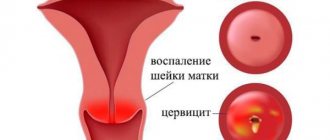Women often ask the question: why does brown discharge appear during ovulation? Such discharge is often regarded by them as a sign of some kind of pathology. The thing is that changes constantly occur in the reproductive organs of women, and especially during the period of ovulation. This phase of the cycle is very important. A clear understanding of the processes occurring during pregnancy will allow you to correctly plan conception or, conversely, avoid unwanted pregnancy, as well as suspect possible pathologies.
To understand why brown discharge may appear during ovulation, and whether this is normal, you should remember what processes occur in a woman’s body at this time.
- Maturation of the egg.
- Ovulation.
- Release of the hormone progesterone.
- Menstruation if fertilization has not occurred.
At any stage of the menstrual cycle, special attention should be paid to the mucous secretions of the cervix. They are almost always present and under the influence of hormonal changes, their consistency changes.
Ovulation process
To understand why brown discharge may occur during ovulation during this period, and whether this is the norm, you should know what processes occur in the female body when the egg matures. And the following happens:
- follicle maturation;
- release of the follicle (ovulation);
- release of the hormone progesterone.
At any period of the menstrual cycle, attention must be paid to mucous discharge. They are always present and under the influence of physiological changes their consistency changes.
Around the second week of the cycle, ovulation begins. A mature egg emerges from the ruptured follicle and begins to move into the uterus.
Why does discharge occur exactly on the eve and on the days of ovulation?
Only during menstruation and during the period of egg maturation is the cervical canal open. On other days, it is closed by a mucus plug to prevent the entry of pathogenic microbes. Twice it moves away, and the neck opens:
- During menstruation, to ensure the discharge of the endometrium;
- During ovulation for unhindered transport of sperm.
Therefore, the uterus, as the most likely source of bleeding, is cleansed precisely on these days.
Attention! Women with a stable cycle are able to determine ovulation by discharge almost accurately.
What influences the process?
Ovulation can be influenced by the following factors:
- abortions and gynecological operations;
- hormonal background;
- spontaneous miscarriages.
Such pathological phenomena entail a lot of negative consequences. In addition, the cycle is disrupted for other reasons: taking medications, thyroid diseases, the presence of sexually transmitted infections, etc.
Possible diseases
Sometimes brown discharge during ovulation is outside the normal range and can be a cause for concern. They can be identified by the following characteristics:
- intensity;
- foreign odor;
- abundance.
In the presence of genital infections, specific discharge is observed, which may have a dirty pink or brown tint and be accompanied by purulent discharge. Pathological discharge occurs mainly in the middle of the cycle, since at this time, under the influence of hormones, sexually transmitted infections tend to worsen.
In addition, brown discharge during ovulation may be associated with hormonal imbalance, which occurs as a result of the use of inappropriate oral contraceptives, as well as during addiction to them or against the background of thyroid diseases.
Cervical erosion has approximately the same manifestations. Its development leads to the destruction of the cells of the epithelial layer covering the neck and the formation of wounds on it. In this case, a woman may experience brownish discharge, insignificant and spotting. If this pathology is not treated in time, inflammatory processes may develop, which are the result of a bacterial infection.
If a woman’s discharge in the middle of her cycle is brown and has a strong unpleasant odor, this may be the first sign of neoplasms in the pelvic organs. This symptom is very serious and should not be ignored.
Brown discharge is normal
Brown discharge during ovulation can be either normal or pathological, indicating the presence of serious processes.
They can be considered normal in the following cases:
- with rare occurrence;
- in the absence of pain and unpleasant odor;
- when appearing within one to two days.
In such cases, brown discharge during ovulation is considered a sign of follicle rupture and the release of a mature egg. This process is accompanied by the formation of the corpus luteum, damage to the walls of the follicle, around which there are many small vessels. When some of them rupture, blood enters the cervical mucus and the discharge appears brown.
How to determine ovulation by discharge
To determine the onset of ovulation, a woman needs to listen carefully to her body. Observation over several cycles will help identify characteristic changes in discharge when a mature egg is released:
- increase in the number of secretions
- The discharge has a consistency similar to egg white
- possible presence of blood spots
This method is not the most reliable in determining the moment of ovulation. It is best used in conjunction with other methods of calculating the most favorable time for conception. The most accurate of them are keeping a basal temperature chart and using special tests.
Pathologies
If a similar phenomenon occurs in the middle of the cycle and has minor, painless manifestations, you can consider this a normal ovulatory process and not worry. In other cases, brown discharge after ovulation is not harmless and is a sign that certain pathological changes have occurred in the female body that have affected the reproductive system.
The following pathologies may be the causes:
- bacterial infection;
- ectopic pregnancy;
- venereal disease;
- endometriosis;
- cervical injury.
What kind of discharge should you see a doctor for?
A woman should not delay visiting an antenatal clinic when vaginal discharge deviates from the norm and may be symptoms of pathology. The most incorrect and often common decision of women is self-medication. Often, instead of consultation, lovely ladies prescribe treatment for themselves based on articles and reviews on the Internet, advice from friends or pharmacists.
In addition, it is imperative to take into account the characteristics of a woman’s body when choosing treatment, so as not to aggravate the situation, which also speaks in favor of qualified help.
Negative changes in vaginal discharge include:
- bright yellow shades of discharge during ovulation;
- itching and burning of the genitals, which are accompanied by discharge, pain during sexual intercourse;
- discharge of any color and density with an unpleasant odor;
- a lot of discharge after ovulation;
- dark brown, bloody discharge before ovulation;
- The discharge has a consistency close to cheese mass or resembles curdled milk.
To summarize all of the above, a woman should not endure discomfort, any inconvenience, “incorrect” discharge, including this deviation from the norm. Therefore, you should not save time and, as many people think, money. It is better to immediately contact the antenatal clinic. This will give the woman the opportunity to get answers to all questions, proper treatment, and psychological peace of mind.
As life practice shows, those who saved time and money by self-medicating then spend even more to cure advanced diseases and the consequences of self-prescriptions.
Ectopic pregnancy
If a woman has an ectopic pregnancy, brown discharge during ovulation may persist for some time after ovulation, most often about five days. This is a very serious problem that requires urgent action. The success of subsequent therapy and the woman’s ability to have children in the future depend on how quickly the operation is performed.
Cervical fluid, which is brown in color and dangerous, is not like the fluid that occurs during menstruation - bloody. The peculiarity of such mucus, if it is provoked by sexually transmitted diseases, is the presence of purulent elements in it. Such discharge usually has an unpleasant, pungent odor.
One of the most serious consequences that ovulation disorders can cause is infertility, so the appearance of brown discharge in the middle of the cycle, when ovulation is supposed to occur, is dangerous to neglect. Ovulation discharge is normal only in cases where it is transparent and white in color, and lasts no more than two days.
The appearance of thick and abundant brown discharge before ovulation can be the main sign of some gynecological diseases that are very dangerous for women's health.
Ovulation and changes in vaginal secretions
Periodic transformation of vaginal mucus occurs every month. Immediately after the end of menstruation, a dense plug of mucus forms in the cervical canal. It protects the uterus until the moment when it is necessary to pass sperm. There is very little discharge during this period - it is white or creamy, creamy masses of a smearing nature. Some women do not notice any whiteness at all.
As ovulation approaches, hormones liquefy the plug. Sticky transparent discharge appears. At the moment the egg is released, they are at their most liquid. The consistency is comparable to raw egg white.
After 2-3 days, the thickening process begins. Leucorrhoea acquires a light or creamy shade and a creamy structure, the amount is moderate. On the eve of the next cycle, the reproductive system is cleansed with watery discharge.
Attention! How long certain processes last depends on the stability and duration of a particular woman’s cycle.
Ovulatory bleeding
The egg matures in a special capsule - a follicle on the surface of the ovary. On the day of ovulation, the walls burst to release it. Microtrauma is accompanied by the release of several drops of blood. When leaving the vagina, they color the mucus in different shades. So brown, brown and pink discharge in the middle of the cycle is a sign of ovulation. The color depends on the rate of clotting and the duration of blood passage through the uterus into the vagina and out.
Logically, the symptom occurs when the process has occurred, that is, during or after the maturation of the egg. However, it is not always possible to accurately calculate day X. A woman may believe that her ovulation will begin on the 14th day, but everything happened on the 12th day.
Diagnostics
If any pathological discharge occurs, a woman should consult a doctor and find out the nature of its origin. This is necessary in order to avoid the development of a possible pathological process and cure the disease at the earliest stages.
The specialist must carry out the correct diagnosis, which includes a whole range of procedures. First, the doctor must examine the woman on the gynecological chair, using special instruments and palpation techniques. This helps to identify primary signs of pathology and suspect the presence of tumor processes in the genital organs.
In addition, diagnosing the causes of brown discharge during ovulation includes conducting certain laboratory tests. In this case, general blood and urine tests, smear and cervical mucus examination are performed. A necessary diagnostic measure is a blood test for sex hormones and those produced by the thyroid gland, since changes in hormonal balance also entail a disruption of reproductive functions. Hormone tests are carried out based on the days of the menstrual cycle, with a certain hormone reaching the required level on a certain day. This must also be taken into account by the doctor when prescribing such studies.
Functional diagnostics also helps to determine the causes of brown discharge in a woman during the ovulatory period. It involves conducting an ultrasound examination, which reveals structural abnormalities of organs and possible pathologies.
Treatment
Treatment for brown discharge during ovulation depends on what disease was detected in the woman during diagnosis. If she is diagnosed with an ectopic pregnancy, the doctor prescribes an urgent operation to remove the fertilized egg from the lumen of the fallopian tube.
If sexually transmitted or inflammatory diseases are detected, the woman is prescribed a course of therapy with antibacterial and anti-inflammatory medications, to which a specific type of infectious pathogen is sensitive. Such drugs can be taken orally and come in a variety of topical forms, such as vaginal suppositories.
In cases where brown discharge during ovulation is the result of certain hormonal imbalances, treatment should be carried out by a gynecologist-endocrinologist, who selects a hormonal therapy regimen in each case individually, taking into account the diagnosed levels of any hormone.
Advice from a gynecologist
Gynecologists always recommend that women be attentive to their health and, if any pathological phenomena occur, seek help in a timely manner, since diagnosing and treating a disease in the early stages of its development is much easier and safer than at an advanced stage. Experts advise women who experience brown discharge during ovulation to monitor it and their well-being - if nothing hurts, the body temperature does not rise, and spotting stops after a couple of days, then, as a rule, there is no reason for alarm. This phenomenon is directly related to the natural ovulatory process, which from time to time may be accompanied by brown discharge. If the discharge does not stop for more than three days, the amount of discharge exceeds the norm, and the woman is bothered by pain in the pelvis - this is a sign that she is developing a certain disease or an ectopic pregnancy, and this is a reason for an urgent visit to the doctor. This is especially true if a woman observes brown discharge after ovulation several times a year or every menstrual cycle.
Preventive measures
Pathological discharge is primarily a sign of gynecological diseases, and not ovulation, therefore, to prevent more serious problems, the following preventive measures must be observed:
- closely monitor your menstrual cycle - keep a diary or use special applications on your smartphone, where you can note the duration of the cycle, well-being, basal temperature readings and what the discharge looks like,
- visit a gynecologist for preventive consultation and examination at least 2 times a year, and more often when planning pregnancy (if necessary, after each ovulation),
- perform hygiene procedures daily using special intimate hygiene products with a neutral pH level, and before ovulation try to completely avoid the use of any cosmetic products,
- use sanitary disposable pads in case of heavy discharge and try to change them as often as possible,
- give preference to underwear made of natural cotton breathable fabric,
- douche as rarely as possible with various herbal decoctions and other liquids (only on the recommendation of a specialist),
- individually select contraceptives together with a gynecologist,
- have regular sex life with one trusted sexual partner or try to avoid promiscuity without using a barrier method of contraception.
( 1 ratings, average: 5.00 out of 5)
Patient reviews
In the majority of women who observed brown discharge during ovulation, no pathological disorders were identified. They note that the discharge began approximately 10-13 days from the start of the new cycle and did not last long - one or two days. In this category of women, this phenomenon was associated with the natural release of the egg and injury to small capillary vessels, which led to minor brown discharge during ovulation.
The reviews don't end there.
Another group of women who encountered a similar phenomenon note that it was caused by some inflammatory processes provoked by infection, hypothermia, etc. They required medical treatment, which most often included taking antibiotics and anti-inflammatory drugs. The discharge itself in such situations had a bright character - cinnamon color, abundance, intensity of discharge. With inflammation, according to patients, brown discharge can manifest itself not only during the period of ovulation, but also on any other day of the cycle, so other women are advised to be on the alert and consult a doctor in a timely manner.









